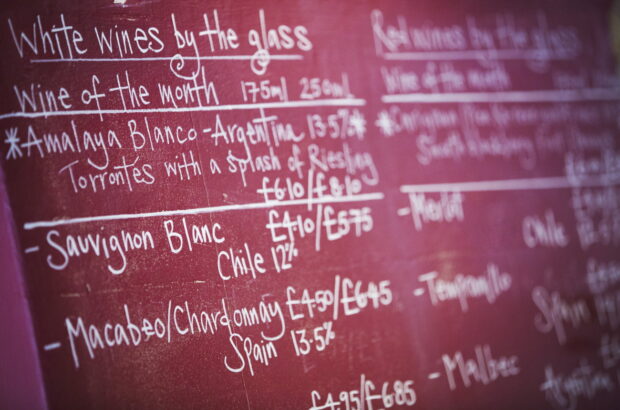Two-starred Michelin chef Alain Dutournier talks to Decanter.com at Château La Dominique in St-Emilion about the new wave of Bordeaux winery restaurants - recalling a time when merchants and high society were content to eat noodles with red wine at the city's Quai des Chartrons. Plus, see his ultimate, end-of-the-world wine list.
People who eat meat should be prepared to watch animals being killed and failing to respect the history of the land ‘is a crime’; Michelin chef Alain Dutournier is not short of passionate opinions on the subjects of wine and food, and not afraid to express them.
Michelin inspectors crowned Dutournier the ‘mastermind’ of French tapas this year, for his work at Mangetout in Paris.
But, his main focus is running one of the most respected restaurants in the city, two-starred Carré des Feuillants, with a 3,500-strong wine list – alongside managing a ‘garden vineyard’ in his south-west France homeland.
He took a break during Bordeaux en primeur week to join three other high-profile French chefs in cooking lunch on separate days at La Dominique’s Terrasse Rouge restaurant in St-Emilion – a project curated by consultants Dany and Michel Rolland to highlight the growing gastronomic culture in Bordeaux vineyards.
The rise of restaurants at Châteaux
‘A long time ago, many wine people didn’t know about food.’

View from La Terrasse Rouge. Credit: Château Dominique / Terrasse Rouge.
Tourism and food are becoming important business for estates. La Dominique did 50,000 covers at its La Terrasse Rouge restaurant in 2016, after opening in spring 2014.
This year’s Michelin Guide for France also praised several estate owners on Right and Left banks. Whatever you think of the tyre manufacturer’s star system, it has highlighted a trend.
‘I find this very interesting. A long time ago, many wine people didn’t know about food,’ said Dutournier, born in 1949.
‘My mother was born in Bordeaux and when I was young she told me that in the Quai des Chartrons, high society people drank St-Emilion wines with noodles.
‘In my region, the south-west, we have great cooking. But many people from the vineyards didn’t care about food for a long time.
‘Now, things are changing. So I think it’s a good idea to bring the restaurants to areas where people can also drink the wines.’
He’s not so sure about wineries opening restaurants outside of their regions, however. ‘It’s something I don’t understand,’ he said.
See also: Jane Anson’s top Bordeaux restaurants owned by châteaux
Fish and red wine: Yes, you can – with some help from bone marrow

Famous James Bond quote in ‘From Russia With Love’. Illustration Credit: Pen
At La Terrasse Rouge, Dutournier cooked red mullet for a packed room; surely a risk to opt for fish amid a tannin-laden en primeur week, and in St-Emilion, too?
‘I thought all my friends would do dishes with meat, so I tried to do something with fish.’
Red mullet, he said, has the density and texture to cope. ‘The liver of this fish is very interesting for red wine. When it is fresh and good quality, it tastes like the ocean but it is quite meaty.’
Veal stock and bone marrow were two other secret weapons in drawing the dish together with the red wine – in this case, La Dominique 2008 and 2012. ‘The marrow is the go-between for fish and meat,’ he said.
If you could drink one more wine on earth…

The d’Yquem 1937 is third from the left in this lot auctioned at Sotheby’s in 2014 in London. Credit: Sotheby’s
As a Michelin chef, Dutournier has had the chance to taste some of the world’s great wines.
If he could only drink two more in his lifetime? DRC’s Romanée-Conti 1934 and d’Yquem 1937 make the list, but Château Margaux 1900 comes close behind.
He recalled being at a French embassy dinner in which each guest was supposed to bring a methusaleh of their favourite wine.

Margaux 1900. Credit: Sotheby’s 2015.
‘I was sitting next to a man and he said that he was very anxious, because he didn’t bring a methusaleh, but had a double magnum. I asked him what he brought and he said Margaux 1900. I have had this wine four or five times and it is one my favourite wines in my life.’
Dutournier’s ‘garden vineyard’ in south-west France includes Tannat, Cabernet Sauvignon and Merlot. He also a bit of Petit Manseng and Baroque, an indigenous, local white variety that he describes as a little bit like Semillon.
In a final flourish, this brings Dutournier on to Semillon itself. He hopes it will continue to be cherished amid a greater focus on Sauvignon Blanc in Bordeaux. ‘Sauvignon Blanc is nice in Sancerre,’ he said.
This article replaces Jane Anson’s regular column for this week only. Jane is currently writing up hundreds of ratings and tasting notes for Bordeaux 2016 en primeur wines, and these will be available on Decanter.com shortly.
More articles like this:

Anson: Guide to the new wave of Bordeaux châteaux restaurants
Why Bordeaux wine tourists are now spoilt for choice...

Restaurant Wine List Quiz – test your knowledge

Anson: Best Bordeaux restaurant wine lists
Jane Anson names exciting sommeliers in the city...

How to visit Bordeaux’s 80m euro wine theme park – Cité du Vin







